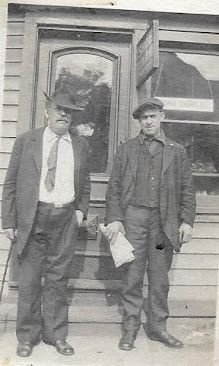Today I was looking at my family tree profile for Private Charles M. Garner, my third-great-uncle. His story is a tragic one. Charles was born in the spring of 1836 in rural Cayuga County, New York, to Jeremiah Garner and Clarinda Wood. He led a simple life; he acquired a farm and in 1860 married the widow Mary Conley Gibbs. Two years later their first child, Harriet Amelia, was born. A typical, quiet life that was about to be shattered by national events.
The war began on the 12th of April 1861, when Confederates in South Carolina fired on Fort Sumpter in Charleston Harbor. While most Americans believed the conflict would be short, the opposite proved true, and as hostilities dragged on Congress passed a conscription act in March of 1863. As required, Charles registered for the draft in June of that year. Within a month he received a notice like the one below.
 |
| Civil War draft notice |
Charles began preparations for his departure, spending time with his mother, (his father had abandoned her by then), and friends, putting his farm in order, and no doubt worrying how the wife he was leaving behind would manage without him. He wasn't aware then, nor was Mary, that he was also leaving behind an unborn son. Albert was born on May 14, 1864 indicating Charles probably reported for duty in August of 1863.
Now assigned to Company I of the 97th NY Infantry, Charles arrived in Washington D. C. near the fall of 1863, in time for some minor battles followed by the setting up of winter camp. In May of 1864 his regiment, now under the command of General Grant, moved south to Virginia to participate in the Richmond-Petersburg campaign. Around this time Charles received word of the birth of his son. Part of Grant's strategy called for the destruction of a section of the Weldon Railroad in order to isolate Petersburg. Charles' company I was to be part of the assault. The battle commenced on August 18th with heavy Union losses, but by the end of the day they held a precarious grip on the railroad. The following day saw another attack by the Confederates, halted only by the last-minute arrival of Union reinforcements. When the smoke had cleared, the Confederate supply line had been taken, but so had Charles.
Now began a dreadful wait for Mary, who knew only that her husband had been reported missing in action. How or when she learned he was a prisoner of war is not something I've been able to find, but from the Smithsonian's web site I discovered soldiers on both sides were allowed to exchange mail. Prisoner's letters were collected and opened at designated sites, censored, then sent on their way to anxious friends and relatives. It's possible Mary heard the disturbing news of her husband's capture from Charles himself.
Prisoner exchanges, done routinely early in the war, had ground to a halt in mid-1863 over the south's refusal to treat black and white soldiers equally. After his capture Charles was initially confined at Richmond, then in early October he, along with five thousand other soldiers, was transferred to Salisbury prison. At the end of October another five thousand prisoners arrived. Those huge transfers along with the Union blockade, which was causing shortages of food and medicine all over the south, in addition to the rising numbers of untraded prisoners, overwhelmed Salisbury and conditions there were rapidly deteriorating. Prison hospital records show Charles was admitted in mid November of 1864 for treatment of diarrhea, released two weeks later, then readmitted on December 22nd. He died there two days later, Christmas Eve, from diarrhea. The NY Town Clerk's Registers, available on Ancestry, attribute his death to exposure and starvation. In all likelihood it was a combination of all three factors.
As I looked over the hints on Charles' page, I saw one for New York's 1865 census. That couldn't be, he was long deceased by then. Pulling it up I saw it was indeed Charles, along with Mary and their family, his occupation-- Army. Investigating further, I read the instructions given to census takers that year which stated they should include the names of those who had died since the first of June, the official date of the census. Charles had been gone six long months, did Mary not know that? Checking Schedule III of the census, Inquires Relating to Officers and Enlisted Men, I found Charles listed as a prisoner who died at Salisbury but with a caveat, that is difficult to read...

 |
| Looks to me like it says, Reported Dead Family Cannot Ascertain anything about? |
I take the above to mean the family had received no information about the manner or time of Charles' death. Was he enumerated because Mary was still hoping for a miracle? It seems she was. As I looked at Schedule VII at the end of the census, Deaths of Officers and Enlisted Men, I saw Charles' name was not there, his family had not given up on him.
Mary finally had to accept the hard truth of Charles' death, and she did marry again about four years later. Her new husband, Mortimer Hilliker, was a Michigan farmer in which place Mary and her children took up their residence. Hopefully she found a bit of happiness, but I would not be surprised to find that on quiet evenings when the endless farm chores were done and the stars twinkled overhead, Mary's thoughts sometimes drifted back to her young, lost husband.






















